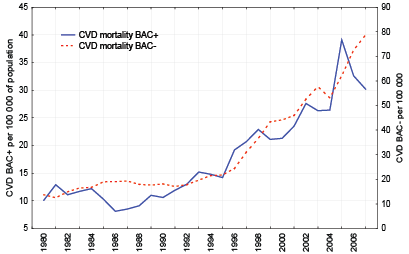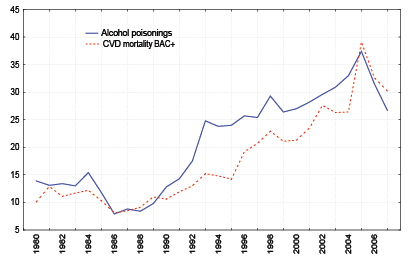
Figure 1: Trends in BAC-positive and BAC-negative cardiovascular mortality in Belarus.


Razvodovsky YE*
International Academy of Sobriety, Grodno, Belarus*Corresponding author: Razvodovsky YE, International Academy of Sobriety, 80 Gorky Street, Grodno 230009, Belarus, Tel: + 375 0152 70 18 84; Fax: +375 0152 43 53 41; E-mail: razvodovsky@tut.by
Background: The mounting body of research evidence point to binge drinking pattern as a potentially important contributor to cardiovascular mortality crisis in the former Soviet republics.
Aim: To analyze the trends in BAC (blood alcohol concentration)-positive and BAC-negative cardiovascular mortality in Belarus between 1979 and 2007 in relation to binge drinking.
Method: Trends in fatal alcohol poisoning (as a proxy for binge drinking) and cardiovascular deaths from 1980 to 2007 were analyzed employing a distributed lags analysis. In all 155616 cardiovascular deaths (ICD-10 codes 100-99) and 59489 fatal alcohol poisoning (code X 45.0-45.9) cases were examined with respect to the Bureau of Forensic Medicine autopsy reports.
Results: Alcohol in blood was found in 37.5% victims of cardiovascular mortality for the whole period, with the minimum figure 29.8% in 1986 and maximum 50.8% in 1981. Alcohol-related cardiovascular mortality was more affected by the restriction of alcohol availability during anti-alcohol campaign: between 1989 and 1986 the number of BAC-positive cardiovascular deaths shrank by 33.6%, while the number of BACnegative deaths increased by 14.4%. The outcomes of distributed lags analysis suggest statistically significant association between the number of fatal alcohol poisoning and the number of BAC-positive cardiovascular deaths at zero lag.
Conclusions: The findings from this study provide support for the binge drinking hypothesis, suggesting that episodic heavy drinking of spirits is an important determinant of cardiovascular mortality crisis in the former Soviet republic Belarus.
Cardiovascular disease (CVD) remains the leading cause of death in Europe and despite recent decreases in mortality rates in many countries, it is still accounting for over 4.35 million deaths each year [1]. The burden of CVD in Europe varies dramatically between countries [2]. The former Soviet republic Belarus has one of the highest CVD morbidity and mortality rates, accounting for 60% of all deaths in the country [3]. The main diseases that define a high level of mortality from CVD are coronary heart disease (CHD) and cerebrovascular diseases, which are responsible for 67 percent and 26 percent of deaths, respectively [4]. A distinctive feature of CVD mortality in Belarus is that the high rates occur in working age population, especially in males [3].
It was emphasized that alcohol provides the most plausible explanation for both the high rate and the dramatic fluctuation in Belarus CVD mortality rate during the last decades, while other traditional risk factors identified in epidemiologic studies had little predictive value [3-6]. This hypothesis based on a fairly close temporal covariation between trends in overall consumption and CVD mortality during Gorbachev’s anti-alcohol campaign [3,4,7-9].
Gorbachev’s anti-alcohol campaign in the former Soviet Union is the most well-known natural experiment in the field of alcohol policy [10]. In May 1985 Gorbachev launched the anti-alcohol campaign which was design to tackle alcohol-related problems in the Soviet Union by raising the price for vodka, restricting the sale by amount and time of day, closing vodka distilleries and destroying vineyards [11].
Gorbachev’s anti-alcohol campaign did produce a number of positive effects, such as a decline in alcohol consumption, a drop in alcohol-related mortality [10]. The campaign also precipitated a spike in the production of moonshine (samogon) and decline in state revenues, which fuelled inflation. For all these reasons, the campaign was formally abandoned in 1988 [11]. Thirty years latter, speaking on the anniversary of the start of the anti-alcohol campaign, Gorbachev acknowledges that his campaign was a mistake, stressing that it should had been gradual and relentless.
Belarus ranks among the world’s heaviest drinking countries with an annual official consumption rate more than 12 litres of pure alcohol per capita [12]. Furthermore, according to the WHO (World Health Organization), in 2010, Belarus appears at the top of global rating with 17.5 litres of total alcohol consumption (including unrecorded consumption) per capita [13].
The primary aim of this study was to assess the proportion of individuals who died from CVD with alcohol detected at autopsy. A second aim was to analyze the trends in BAC-positive and BAC-negative cardiovascular mortality in Belarus between 1980 and 2007 in relation to the trend in alcohol poisoning rate (as a proxy for binge drinking). The underlying hypothesis is that alcohol-restricting policies during Gorbachev’s antialcohol campaign could play a role in limiting BAC-positive cardiovascular mortality.
The data on cardiovascular deaths and fatal alcohol poisoning used in the article were based on autopsy reports from Bureau of Forensic Medicine. In all 155616 cardiovascular deaths (ICD-10 codes 100-99) and 59489 fatal alcohol poisoning (code X 45.0-45.9) cases were examined with respect to the Bureau of Forensic Medicine autopsy reports. In Belarus, all violent deaths, all sudden deaths at working ages and cases with an unclear diagnosis are routinely subjected to forensic autopsies, which include blood alcohol concentration (BAC) inspection. The autopsy rate for deaths from alcohol poisoning and CVD at working ages was about 100%. BAC in samples collected by forensic pathologists during the medical autopsies was assessed by gas chromatography and reported per million (0/00). BAC over 0.5 0/00 was termed ‘inebriation’ and denoted as ‘BAC-positive’.
It should be noted that the alcohol poisoning rate as an indicator of binge drinking may better capture the magnitude of an intoxicationoriented drinking pattern than official sales statistics and an expert estimation of the total level of alcohol consumption [7]. Thus, a common approach is to use the fatal alcohol poisoning rate as an indicator of binge drinking [12].
The statistical analysis was performed using the package “Statistica”. It is generally agreed that bivariate correlations between two raw timeseries are spurious due to common sources of trends and autocorrelation [8]. Therefore in order to reduce the risk of obtaining a spurious relation between two variables that have common trends, the trends should be removed by means of a differencing procedure: ∇xt = xt - xt-1 this means analyzing annual changes rather than raw data [14]. The process of removing systematic variation within time series prior to the examination of potential causal relationships is referred to as “prewhitening”. The residuals of a statistically adequate time series are distributed as a white noise process. A further step entails the inspection of the cross-correlation function in order to estimate the association between the two prewhitened time series. We used this method to estimate the relationship between the time series alcohol poisonings (as a proxy for binge drinking) and BACpositive and BAC-negative cardiovascular deaths in this paper.
Alcohol in blood was found in 37.5% cardiovascular mortality victims for the whole period, with the minimum figure 29.8% in 1988 and maximum 50.8% in 1981. During the anti-alcohol campaign of the mid-1980-s the number of BAC-positive cardiovascular deaths decreased substantially, with a subsequent increase in the early 1990s (Figure 1). Although the trends for BAC-positive and BAC-negative cardiovascular deaths are rather similar over time series, there are differences (Figure 1). For example, there is marked discrepancy between the two time series in the 1980s: between 1984 and 1986 the number of BAC-positive cardiovascular deaths drops by 33.6%, while number of BAC-negative cardiovascular deaths increased by 14.4%. Further, the upward trend across the time series has been greater for BAC-negative cardiovascular mortality than for BAC-positive cardiovascular mortality. The graphical evidence also suggests quite a strong association between BAC-positive cardiovascular deaths and fatal alcohol poisonings trends (Figure 2).

Figure 1: Trends in BAC-positive and BAC-negative cardiovascular mortality in Belarus.

Figure 2: Trends in BAC-positive cardiovascular mortality and fatal alcohol poisonings in Belarus.
The Spearman’s correlation analysis suggests the strong positive relation between fatal alcohol poisoning rate and the numbers of BAC-positive (r=0.96; p=0.000), and BAC-negative cardiovascular deaths (r=0.81; p=0.000). As can be seen from figures 1-2 there is linear trend in the time series. This trend was removed by means of first-order differencing procedure. After pre-whitening the cross-correlations between alcohol poisoning and cardiovascular deaths time series were inspected. The outcome indicated statistically significant cross-correlation between fatal alcohol poisonings and BAC-positive cardiovascular deaths (r=0.70; SE=0.20) at zero lag. At the same time, there is no relation between the fatal alcohol poisonings and BAC-negative cardiovascular deaths (r=0.16; SE=0.20). So, positive correlation between these variables was spurious.
This is the first study on the association between binge drinking and cardiovascular mortality in Belarus. We have found that a high proportion of people (37.5%) who died from CVD at working ages had consumed alcohol before death. This proportion is considerably lower than that found in Russian city Barnaul as 45-50% [15].
Natural experiments, such as sudden and large changes in alcohol consumption level, provide an opportunity to test the efficacy of policy attempts to reduce the rate of alcohol-related problems in the population. Gorbachev’s anti-alcohol campaign in the 1985-1988 is the most wellknown natural experiment in the field of alcohol policy [10]. It seems obvious that sudden decline in CVD mortality rates between 1984 and 1989 appears to be entirely due to anti-alcohol campaign that significantly reduced alcohol consumption by limiting its manufacture and availability. Further, the fact that alcohol-related cardiovascular deaths were more affected by the restriction of alcohol availability during the Gorbachev’s anti-alcohol campaign may be used as evidence suggesting that alcohol is responsible for a substantial number of CVD deaths in Belarus. This empirical evidence indicates that a restrictive alcohol policy can be considered as an effective measure of CVD mortality prevention in countries where rates of both alcohol consumption and CVD mortality are high.
The results from the time series analysis suggest positive relationship between fatal alcohol poisoning (as a proxy for binge drinking) and BACpositive cardiovascular deaths at zero lag. In this case the independent variable is directly influencing the dependent variable and there is no evidence of a lagged relationship between the two time series. This immediate response in cardiovascular mortality to a change in alcohol consumption is expected, given the well known negative effect of binge drinking, which is common in Belarus [12]. This may support the point that binge drinking, which results in a quicker and deeper intoxication is a risk factor for cardiovascular death. This research evidence is consistent with the findings from previous studies highlighted that vodka consumption as measured by sale was significantly associated with CVD mortality rates [4,8]. Assuming that drinking spirits is usually associated with intoxication episodes, these findings provide additional evidence that drinking pattern is important determinant in the alcohol-CVD mortality association.
In conclusion, we have found that a high proportion of people at working ages dying from CVD consumed alcohol before death. Te findings from the present study suggest that alcohol drinking and BACpositive CVD mortality rates are positive related phenomena in Belarus. The outcome of this study also provides aggregate-level evidence in support of the hypothesis that binge drinking is key to explaining the heavy burden of CVD mortality in Belarus. This compelling evidence have important policy implications suggesting that that cardiovascular mortality prevention programs should focus more on addressing the drinking pattern.
Download Provisional PDF Here
Article Type: Research Article
Citation: Razvodovsky YE (2016) The Effect of Gorbachev’s Anti-Alcohol Campaign on Cardiovascular Mortality in Belarus. J Hear Health 3(1): doi http://dx.doi.org/10.16966/2379-769X.130
Copyright: © 2016 Razvodovsky YE. This is an open-access article distributed under the terms of the Creative Commons Attribution License, which permits unrestricted use, distribution, and reproduction in any medium, provided the original author and source are credited.
Publication history:
All Sci Forschen Journals are Open Access